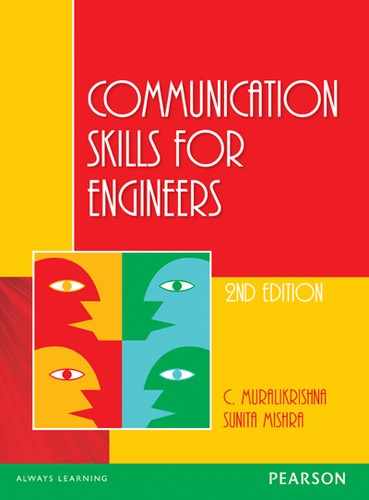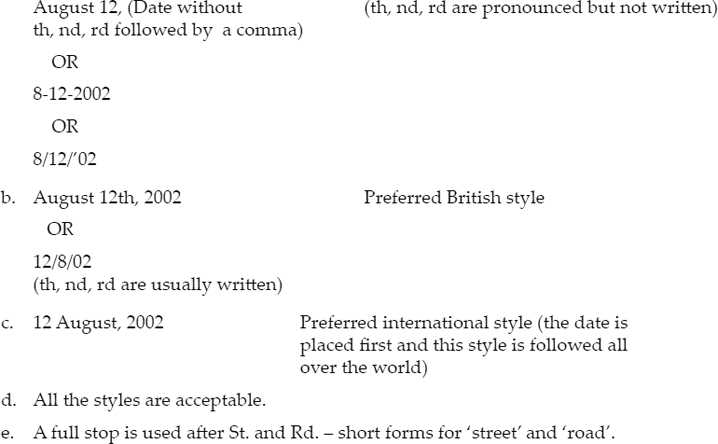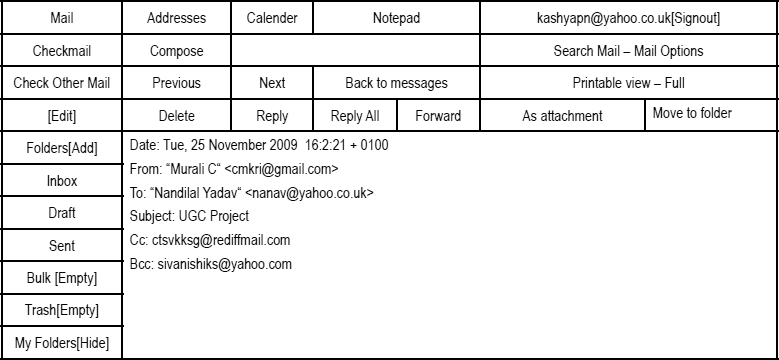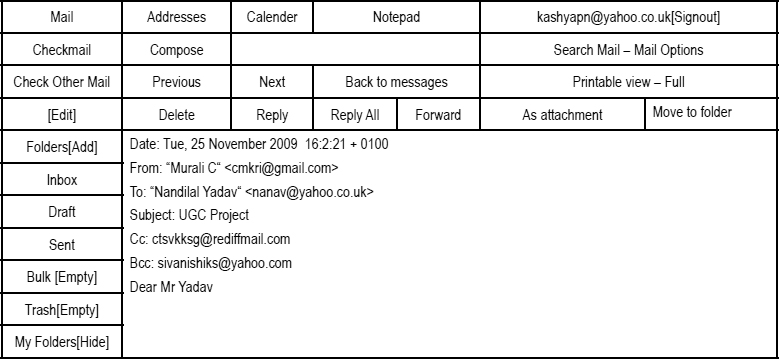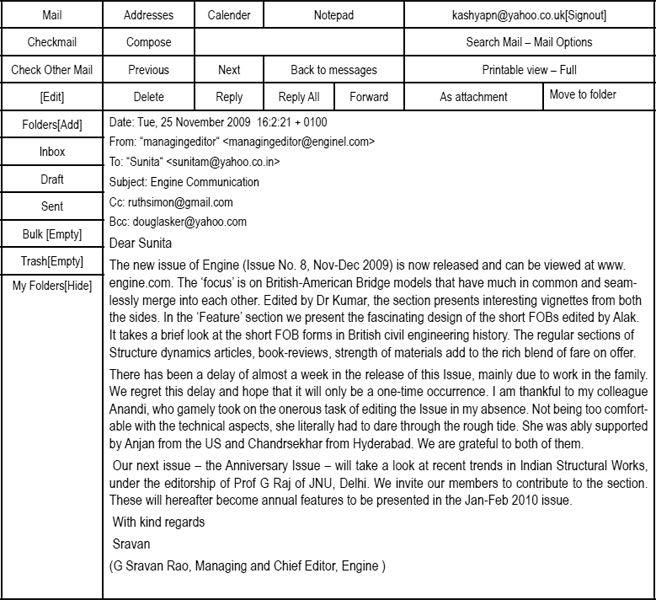CHAPTER 11
Business Letters, Technical Writing, E-mail Writing
Chapter Objectives
This chapter discusses most of the significant aspects relating to business letters, technical writing, and electronic mail (e-mail) messages which have become popular alongside other skills and important features of today's world.
BUSINESS LETTERS
Business letters are letters written in the context of business transactions between individual business personnel or between business organizations. It is essential to familiarize yourself with business letter formats and styles in different business situations and to gain some practice in writing a letter in a given business context. The other formats covering letters of inquiry, request, replies, orders and business reports. Different forms of layout like the indented form, hanging indention, block form, modified block and semi-block are also explained.
A visitor to a certain college paused to admire the new Hemingway Hall that had been built on campus.
“It's a pleasure to see a building named for Ernest Hemingway,” he said.
“Actually,” said his guide, “it's named for Joshua Hemingway. No relation.”
The visitor was astonished. “Was Joshua Hemingway a writer, also?”
“Yes, indeed,” said his guide. “He wrote a check.”
Business Letters: General Layout
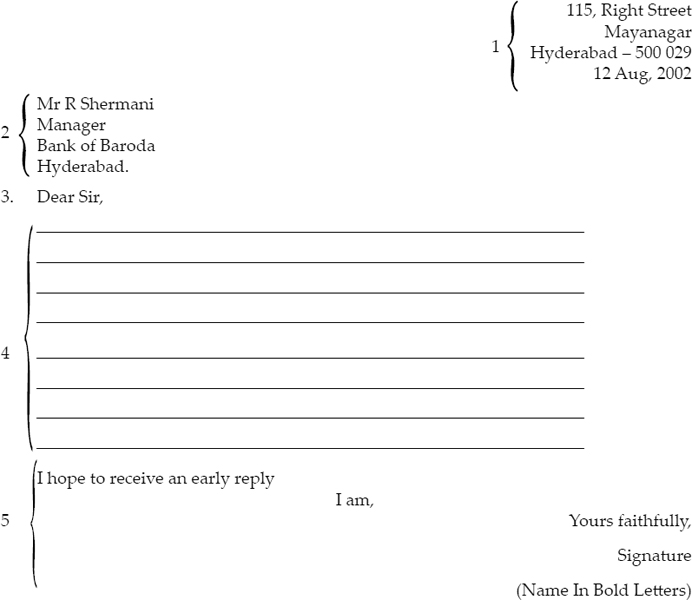
The general layout of a well-written letter has the following important features:
1. Heading

2. Addressee's name above ‘Dear’.
If you are addressing a person by name give the official designation also; if one is applying for a job then only the designation is given and not the name. In business letters, after the name of the person ‘Esq’ may also be added: R. Shermani, Esq. ‘Esq’ is an abbreviation for ‘Esquire’. Never write both Mr and Esq:
E.g. Mr R. Shermani Or R. Shermani, Esq.
“Esquire’ (British English) is used as a title of politeness usually written in its shortened form after the full name of a person
e.g. Kerry Packer, Esq.
Titles and decorations awarded by the State are placed before university degree.
e.g. Mr C. M. Murali Mohan, M.P., Ph.D.
‘Messrs’ (Abbreviation for ‘Messieurs’ which means Gentleman)
is not used when addressing a company whose name is not personal.
e.g. The General Trading Co. Ltd.
but Messrs Shiv & Co. Ltd.
- In the Indian context, some people use Smt/Sri/Kum in their correspondence.
3. The Salutation
| Dear Sir, | My Dear Sir |
| Dear Gentlemen, | My Dear Madam, |
| Dear Madam, | Dear Mesdames, |
- If the name is not known, ‘Dear Sir’ is used.
- If the letter is addressed to a woman, ‘Dear Madam’ is used.
- If the letter is addressed to an organization or firm, ‘Dear Sirs’, or ‘Dear Gentlemen’ is used.
- If it is addressed to an all-women organization, use ‘Dear Mesdames’.
- In a general circular, use ‘Dear Sir or Madam’.
- In formal official letters, one may use ‘Sir’.
- ‘My dear Sir’ is rather old-fashioned.
Official designations after the title may be used in the salutation in letters addressed to persons in their official capacity;
Dear Mr President,
Dear Mr Governor,
Dear Madam Secretary,
Titles other than Mr, Mrs, Miss, Dr are spelt in full
Dear Professor Rao,
Dear Ambassador Kumar.
4. The Body
Common openings in business letters:
- Thank you for your letter of Aug. 12…
- Received your letter of Aug. 12…
- I should like to order …
- I should like to inquire whether …
- I wish to …
- I wish to apply for the position of … advertised in the …
- I wish to complain about …
- I have to complain about…
- Would you please …
- I wonder if …
Formerly, most business letters had a formal style. However, modern business letters are less formal. Avoid the chatty, casual element of the personal letter, but do not use the stiff, impersonal, distant tone that was once adopted for all official and business letters.
The body of the letter may be written in paragraphs. The first line of each paragraph is indented, unless the writer follows open punctuation.
Business jargon, once so popular, is now giving way to plain English;
| Business Jargon | Plain English |
| Inst., or instant | of this month |
| Ult., or ultimo | of last month |
| Prox., or proximo | of next month |
| We are in receipt of your esteemed communication | We have received your letter |
| We hereby beg to inform you | We wish to inform you |
| ‘Re’ | With reference to |
5. Common Endings or Subscription
| e.g. Yours faithfully | (British style in formal business letters) |
| Yours sincerely | (British style in letters between people who know each other by name) |
| Yours truly | (British style in letters where there is no personal relationship between the writer and the addressee) |
| Yours cordially | (British style in a formal letter where there is a desire to sound respectful) |
‘Y’ in Yours must be a capital letter.
- In most cases, American usage prefers to put the adverb before ‘Yours’; Sincerely yours, Cordially yours. (‘Yours’; Sincerely yours, Cordially yours. (‘yours’ in this case does not begin with a capital letter.)
- ‘Yours’ does not have an apostrophe. (Your's is wrong).
- Sometimes ‘I am’, ‘I remain’, ‘We remain’ are used.
e.g. I am,
Yours faithfully,
Signature
Avoid ending a letter with a present participle construction e.g. Hoping to receive an early reply - (wrong) (unacceptable)
I hope to receive an early reply (acceptable)
(Open punctuation)
I am
Yours faithfully
BUSINESS LETTER: SAMPLES
1. A Letter of Inquiry
123, Chickal Road,
Cuttack 795 001
12 March 2002
Vijaya Furniture Company,
Cuttack 795 361.
Dear Sirs,
From your advertisement in the Indian Express of March 4, I understand that you supply wooden and steel furniture in various latest designs.
I would be grateful if you could send me a brochure of the furniture you supply. I am particularly interested in buying furniture for my drawing room
Yours truly
Sd/-
(A.S.KELUCHARAN)
Writing is a kind of therapy. Sometimes I wonder how all those who do not write, compose, or paint can manage to escape the madness…which is inherent in the human condition.
— Graham Greene
2. Reply letter
CUTTACK 795 361.
Telephone: 8621
Telegram: VIJAFUR
20 March 2002
Mr A. S. Kelucharan
123 Chikal Road,
Cuttack 795 001.
Dear Sir,
Thank you for your letter of March 12, asking for a brochure of the items of furniture we can supply.
We are happy to send you herewith details of the wooden and steel furniture available with us. Different designs of furniture for the drawing room are shown on page 14 of the brochure. You have a choice of teakwood and rosewood for these items of furniture.
Wooden furniture can be supplied in a week. The delivery for steel furniture will take up to three weeks.
If there is any other information you wish to have, please write to us. We shall be happy to let you know.
Yours faithfully,
For VIJAYA FURNITURE COMPANY
(XXX)
Sales Manager
3. Placing an Order
VIJAYA FURNITURE COMPANY
CUTTACK 795 361
Telephone: 8621
Telegram: VIJFUR
Our Ref:
Your Ref:
2nd April 2002
Messrs. Azeem Brothers,
Timber Merchants,
Hyderabad – 500 021.
Attention: Mr Abdul Azeem
Dear Sir,
Sub: Our Quotation for teakwood planks
Your letter containing details of your teakwood stock was received today.
We think the teak wood sizes that you can supply will not meet the needs of our customers. Could you, therefore, send us details of planks in plywood you can supply within a month?
A full statement of the sizes and number of planks we need is enclosed. We would be happy to hear from you soon.
Yours faithfully,
For VIJAYA FURNITURE COMPANY,
Sd/-
(P RAMA RAO)
Managing Partner
Encl:
Copy to: Incharge, Carpentary Section
This letter has some extra features. Top left, we find two reference numbers. When there is a long correspondence on a subject and the mail has to be filed for future reference, reference numbers are given. With the help of the reference numbers, the party concerned will be able to trace the previous correspondence on the subject and gather the information required for taking decisions. After the inside address we see another feature, namely, the attention line. Here the name of the person incharge of the subject is mentioned. In a large firm with several sections, the attention line will ensure that the letter reaches the right person in time. Next to the signature at the close of the letter, the number of enclosures with the letter is mentioned at the left hand margin. We can mention either the number of papers enclosed, or give a list of the enclosures.
e.g. Encl: 1. Brochure of items of furniture in stock
If a copy of the letter has been sent to anyone else, that is shown below the list of enclosures.
e.g. Copy: Incharge Head, Carpentry Section.
CHARACTERISTICS OF A GOOD BUSINESS LETTER
- A business letter has to be courteous and considerate.
- It has to be precise and clear.
- It has to be complete.
- It has to be brief.
Read the following model letters. Letter A and Letter B are written by two different secretaries of a company. In both the letters, the purpose of the writers is the same, that is, company sends donation to a social organization.
RADHA IRON AND STEEL INDUSTRY
BB 276, WALKER TOWN, SECUNDERABAD, A.P. 500 032
Tel. 27833056
Ref:
Date: 8/3/03
The Secretary,
R. K. Mission Seva Samstha,
Domalguda,
Hyderabad – 009.
Sir,
We came to know from your notification inst., about your need for funds for a cancer ward in your hospital. As you do social service, you need help from business people like us. We are sending a cheque for Rs.10,000/- in this connection.
Yours faithfully
Sd/- XXX
(Rakesh Bhimani)
Secretary
Radha Iron and Steel Industry
RADHA IRON AND STEEL INDUSTRY
BB 276, WALKER TOWN, SECUNDERABAD, A.P. 500 032
Tel. 27833056
Ref:
Date: 8/3/03
The Secretary,
R. K. Mission Seva Samstha,
Domalguda,
Hyderabad – 009.
Dear Sir,
In the beginning of this month, we read with interest your appeal for funds for the new cancer ward that is being extended in your hospital.
We are aware that your Samstha is doing noble service to the people who need help. Therefore we feel that your Samstha deserves all possible help.
We enclose our cheque for Rs.10,000/- and are sure that your new cancer ward will be of great benefit to many patients.
With best wishes,
We remain,
Yours faithfully,
Sd. XXX
(Umesh Chander)
Secretary
Radha Iron and Steel Industry
It can be observed that letter E is very curt and rude. The tone of the addresser is very arrogant and patronizing. Further, the letter does not follow any of the in-use layout forms. The addresser has also used the archaic business expression ‘inst.’ The letter is written in a single paragraph. Although the letter is brief, it cannot be called a courteous and a polite letter. On the contrary, Letter F reads well and is very appropriate. The tone of the writer is appreciative and humble. The letter also follows the in-use-indented form of layout. It is clear, brief and can be called a very courteous letter. The letter also conveys understanding and appreciation on the part of its addresser. Hence, secretaries for company correspondence can consider Letter F as a good model of business writing.
Business Report Letter
This letter is a simple ‘business report’. It is a blend of the formal and the informal letters: the salutation is generally ‘Dear Mr XXX’ and the subscription is ‘Yours sincerely’. The Regional Manager reports on consumer surveys, company related accidents, insurance claims etc., to the General Manager.
The body of the letter generally has three parts:
- The introduction: the first paragraph of the letter gives a lead to the main part of the report. The introduction to a report contains the background information and the ‘why’, ‘who’, and ‘what’ of the report.
- The body of the report: This contains all the facts or findings. The reporter's remarks are not expressed in this part. If the report requires exhaustive data, an appendix is generally enclosed. The body of the report gives only the gist of the data.
The conclusion: The conclusion contains the following:
- Explication of the facts,
- Reporter's remarks, and
- Suggestions
Look at a sample business letter report:
TOIPS (INDIA) LTD
Nariman Point, Mumbai 400 011.
Branch Office: 20 R.P. Road, Secunderabad 500 002.
20 May 2002
Mr L. K. Basehwar
General Manager,
TOIPS (INDIA) LTD.
Mumbai.
Dear Mr Basehwar
As decided at the meeting of Regional Managers of the company at Mumbai in January, a survey of customer response to our new product FAIR toilet soap was made in Hyderabad during April 1992.
The survey reflected the mixed response of the customers.
- 30% of a representative selection of the population use FAIR toilet soap.
- 60% of the users like the soap, 30% of them find nothing unique in the soap, but would continue using it. 10% expressed dissatisfaction about the soap.
- Nearly 60% of the users complained that the soap dissolved quickly in water, and lasted for a very short time. However they said that the soap did give enough letter.
In view of the results of this survey, I recommend that the Research and Development wing look into the shortcomings and faults, and their findings be placed before the subsequent meeting of Regional Managers in August 2002.
Yours sincerely,
Sd XXX
(P. K. S. Murthy)
Regional Manager
FORMS OF LAYOUT
Business letters can adopt any one of the many acceptable formats. The acceptable formats are as follows:
- Indented Form (traditional form)
- Hanging Indention
- Block Form (more modern form)
- Semi Block
These different forms of layout are shown below:
Layout 1: Indented Form
SENDER'S NAME AND ADDRESS
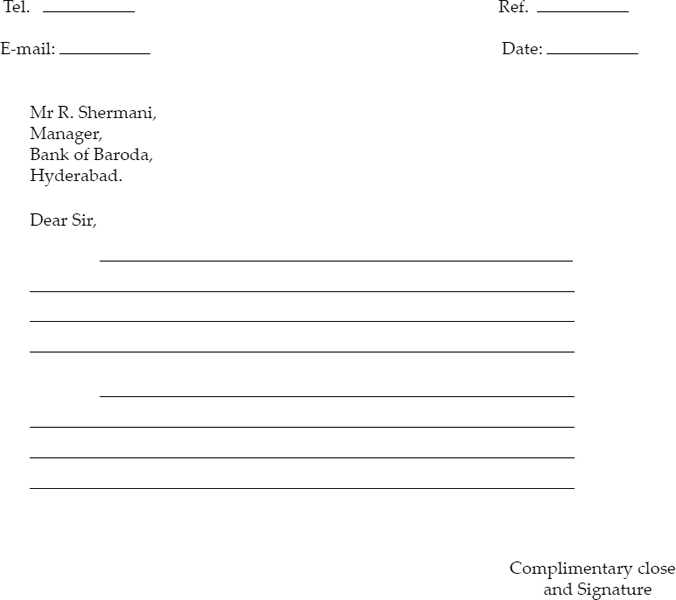
Layout 2: Hanging Indentation Form
SENDER'S NAME AND ADDRESS
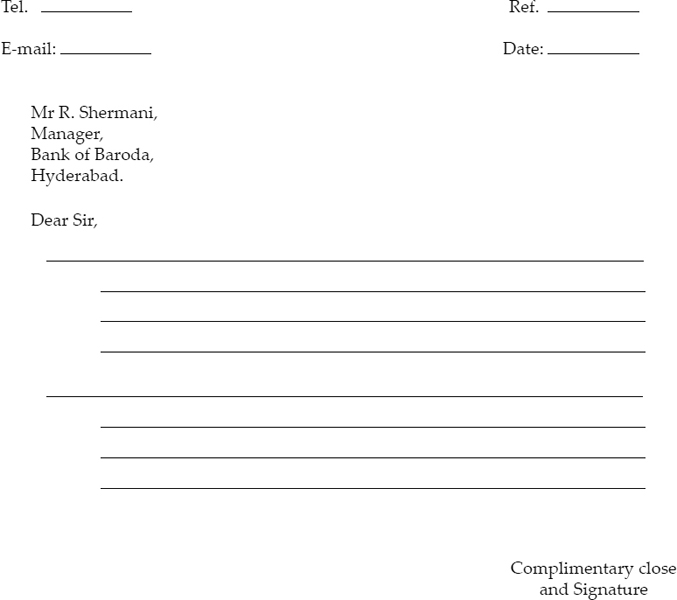
Layout 3: Block Form
SENDER'S NAME AND ADDRESS
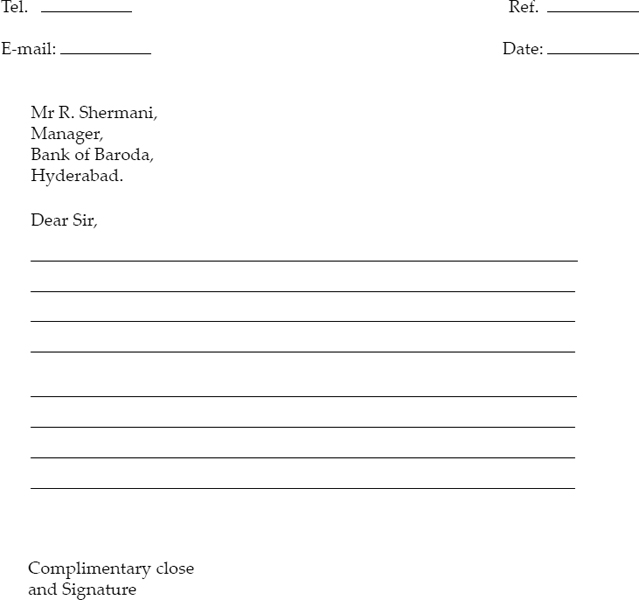
Layout 4: Modified Block Form
SENDER'S NAME AND ADDRESS
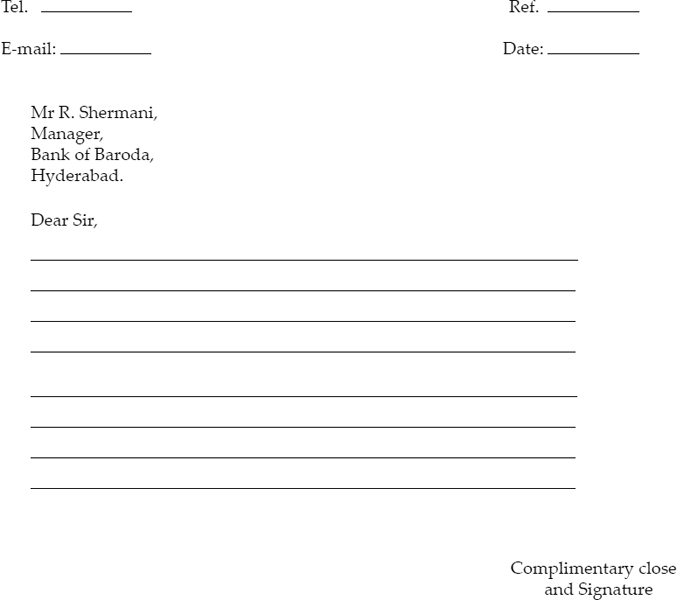
Layout 5: Semi Block Form
SENDER'S NAME AND ADDRESS
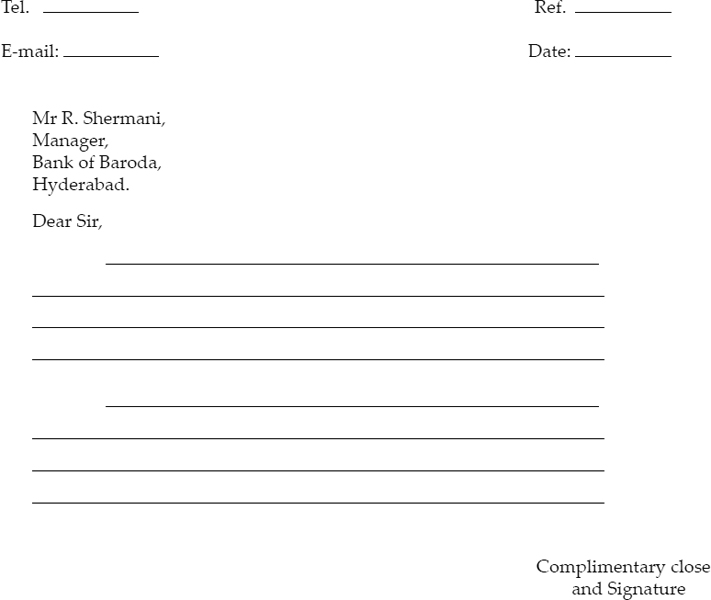
ACTIVITIES
- Draft a business report letter on the basis of a consumer survey conducted for your company's product -an intercom telephone system.
- You agreed to supply intercom telephones to a newly built hotel by a certain date. Write a letter to the hotel manager requesting for extension of time for supplying the equipment.
- An electronic gadget purchased by your department last month is not functioning properly. Complain to the manufacturer who has given you a guarantee for one year.
- A social organization contacts your company and seeks donation for their hospital extension. Write a letter, which is brief, clear courteous and considerate, to the organization in your capacity as Secretary of the company, refusing donation.
TECHNICAL WRITING
Put it before them briefly so they will read it, clearly so they will appreciate it, picturesquely so they will remember it, and above all, accurately so they will be guided by its light.
— Joseph Pulitzer
Introduction
Technical writing is a typical form of writing different from expressive, expository or descriptive writing. Typically, technical writing requires give and take, a dialogue, a follow up, input and action. Most often, it creates action, causes the person at the other end to react or respond. It is also a form of documentation where processes are described, recorded and analyzed. Documentation could also be about the different phases of a product life cycle or even the responses to a certain experiment or exercise. Most often, these are in the forms of reports. It is important to emphasize here that there may not be a single, one and only procedure of reporting or documenting. It is always need, and situation-specific. There are three factors very important for technical writing – purpose, audience and tone. The purpose of writing and the audience very often sets the ‘tone’ of a piece of writing. If you are writing to someone above you, you are probably requesting or recommending action. But if it is someone below you, you are directing action, instructing. Again, if you are writing a report solely for the purpose of documenting, your language will be different. Similarly, if you are presenting a proposal and trying to convince your colleagues, your tone will have to be persuasive.
Technical writing can be of various kinds. There can be reports or documents such as proposals, product specifications, or quality test results. There can be instructions like user guides, online help, training and user manuals. There can even be business proposals, status reports, customer documentation, and e-mail reports. All these kinds of technical writing have unique formats, but there are general features that are common to all of them.
All writing is aimed at achieving some purpose or the other. But technical writing is very specifically aimed at achieving certain purposes. A good training manual will do exactly what it is intended to do. A well-designed and well-written piece of technical writing has to take into consideration some important factors even before the process of writing begins.
Present to inform, not to impress; if you inform, you will impress.
— Frederick P Brooks
Organization and Language
After deciding why the document is to be written, the objectives it is supposed to achieve and the audience it is meant for, the most important factor you must concentrate on is the organization and the language.
Organization
One very important factor in technical writing is clear and orderly organization. Faulty organization can result in the information being distorted and hinder communication. To write with clarity one has to first have an outline of what one is going to present. There is no specific format for an outline. But it has to be variable and flexible to suit the subject and scope of coverage. To have a good outline you must have:
- A clear and emphatic summary of the subject matter.
- The perspective from which you are looking at it.
- Evidence in support of the thesis.
Some of the other techniques that can be used to make writing more organized are:
- Introduction to the subject matter.
- Headings in large font to express transition to new ideas.
- Bulleted lists to draw attention to the subject matter and make comprehension easy.
- The use of figures and illustrations and the help of diagrams and graphs to give immediate visual representation of what is being said.
- A summary that restates the main idea and emphasizes the perspective.
Documentation is the castor oil of programming
—Gerald Weinberg
I guess it's better to have too much information than too little. It makes the manufacturer feel good, keeps writers employed, and makes attorneys work a little harder. Besides, it gives me something to read as I'm eating those chewy white peanuts that came with my new computer.
— Dave Glardon
ACTIVITIES
5. Read the following passage. Give it a title. Identify the main idea, the supporting idea and organize them systematically. (Your answer will appear similar to the pattern given below the passage)
Post-independence generations of Indians came to associate the term ‘scientific temper’ with the maker of modern India, Jawaharlal Nehru. It was he who invited fellow Indians to participate in the adventure of building a strong and forward-looking nation with the help of modern science and technology. A scientific temper required a new approach to life and things, free from obscurantist ideas steeped in irrational dogmas and superstitions. It needed an educational system expressly wedded to the promotion of democratic, socialist and secular values. In actual terms, it meant adoption of the kind of culture that prevailed and prospered in the last three hundred years in Europe and America. The industrial revolution and all that made it possible was part of that culture. Empiricism and experimentation are its backbone. A certain objectivity and avid pursuit of truth based on verifiable facts are its essential concomitants. Such a temper is, in fact, both a cause and an outcome of the modern world.
Title _____________________________
______________________________________
- _______________________________
- _______________________________
- _______________________________
- _______________________________
______________________________________
- _______________________________
- _______________________________
- _______________________________
6. Given below is a write up on the different kinds of crossword puzzles. Give it an appropriate shape, edit it and format it with attention to the font size, numbering pattern, etc.
Three types of crosswords
Prize competition—here the winner surely gets a big prize. It is primarily a gamble where many answers are equally appropriate. By paying a small entry fee here, one can win a big prize.
Intellectual crosswords—here there is only one possible answer to every question. The answer is elusive and calls for some detective work. The clue gives only hints about the word and your comprehension and general knowledge are put to test. It is primarily an intellectual exercise.
Educational crosswords — this is the kind of crossword puzzle where clues or hints about word are given and they have to be found and put in their proper place. The words have to be put in the proper place in the crossword square. This kind of exercise is very helpful as a vocabulary exercise. They can be considered entertaining as simple exercises in problem-solving too!
Theory without practice is sterile, practice without theory is blind.
Technical Description
A technical description can be part of a report or a report itself. It is especially used when the description talks of a new tool, device or a concept. The following are some of the ways in which a technical description is made effective.
Comparisons: technical descriptions often include depiction of unfamiliar objects. This can include description of shapes, angles, colors, size and structures in exact meaningful forms. To do this, we often need to give comparisons with familiar objects. Screws thus have ‘heads’, saws have ‘teeth’, switches have ‘backs’ and the computer has a ‘desktop’. Some of the dimensions along which descriptions are often given are: color, texture, size, quantity, shape.
Something that is being described thus could be parallel, perpendicular, cylindrical, grainy, slippery or smooth. Technical descriptions require that the writer should empathize with the reader and have an idea of the visual image that will be created. Thus very much contrary to common belief, a technical writer has to be creative, has to visualize and empathize with the audience to be able to make an effective presentation that reaches out and communicates.
The following is an example of the use of comparison in technical writing:
A word processor is a piece of software that enables a computer to function like an automated office. With the software the computer works like a typewriter so that you can create your own files: memos, letters, reports and graphics. The computer memory, commonly a disk, acts as a file cabinet from which you can retrieve files, edit them when necessary, and save files infinitely. Acting as a secretary and copier, the word processor controls the format, type font, and the number of copies to be printed on the printer. Some word processors also contain a dictionary and thesaurus to check spelling and word choice and a mail merge function for automatic addressing, which relieves secretaries of these duties.
Generally, a description of an object or device will contain the following:
- Description of the function; the when and why of its use.
- The physical appearance of the object and its component parts one by one. This will include a general description of the object or device and include the dimensions, appearance and components.
- An account of the components in sequential and logical order, including the description of each of them and their relationship with other components. In other words, the manner in which these parts play into the larger function of the devise itself.
- The definition of the idea or object, its overall characteristics, followed by a detailed description of the parts in a logical order.
If you are trying to talk about the computerization of a hotel management system, for example, you'll have to include the following features:
- A detailed description of why this system has to be computerized. This has to include an account of the existing system; the problems in the system and where and how the changes should be brought about.
- The detailed plans of the proposed system—the requirement, the cost estimation and even the models that can be used.
- The ‘designing’—the physical and the logical designing and the “coding”
The last two features that are extremely important are “testing” and maintenance”. Part of maintenance can also be preparation of user manuals etc., which need instructional writing and a very exact use of descriptive writing to explain and describe the functioning or products.
ACTIVITIES
7. Describe a computer to an adult rural Indian who has never seen a computer. While doing so, take care to mention the following:
- the most general use
- comparing it with familiar objects
- giving an overall picture of the parts and describing their interconnection
- Describing the parts in greater detail, their use etc.
- 8. Describe a water filter to a person who has seen it but never used it before. Ensure that you give the correct expressions regarding the shape, size, and texture and functioning of the different parts.
Process Description
The technical description of a process talks about how something works. It talks of the overall function of the process and the materials or skills required. The description most often includes a flow chart or a diagram that can illustrate the sequence of action and the decisive points. A typical process description will have the following elements:
- Introduction or definition that says when and why the process is performed.
- The general operation, which gives an idea as to the skills and time required, the pre-operation and the post-operation conditions.
- Description of the steps—why and when it takes place, how long it lasts and what are the human interventions required.
Whether process description is the description of an operation, a mechanism or a system, the following steps have to be followed:
- Defining the audience: Process descriptions are often used to decide whether a new process should be implemented or a project should be started, etc. Careful choice of the language, words and information thus should be effective and relevant to the audience the material is being presented to.
Selecting an organizational principle: The next important factor in process description is, selecting an organizational principle. The organizational principle for a process is generally chronological. The writer starts with the first action and continues in order till the last. While in some processes, the sequence is obvious, some others require careful examination to determine the most logical sequence. If you were describing the development of cinema, for example, you would clearly follow the chronological order. But if the topic is the complex flow of material from a plant, the sequence has to be based on the audience's knowledge level and the intended use of the description.
In the interests of clarity, it seemed necessary to constantly remind myself to pay not the slightest attention to the elegance of the presentation; I adhered conscientiously to the rule of the brilliant theoretician, Ludwig Boltzmann, to leave elegance to tailors and shoemakers.
—Albert Einstein
- Choosing appropriate visual aids: The third important factor in process description is the use of visual aids. Graphic representations like a flowchart can effectively represent a process and explain the sequences involved. A decision tree can help us to decide whether or not to perform a certain action in a certain situation. Here, at each point, the reader must decide yes or no and then follow the appropriate path.
The following is the description of the hand lever and piston of a paper micrometer, a mechanism used to measure the thickness of paper.
The Hand Lever:
| The hand lever, shaped like a handle on a pair of pliers, raises and lowers the piston. It is made of chrome-plated steel and att aches to the frame near the base of the dial. The hand lever is four inches long, ½ inch wide, and ¼ inch thick. When the lever is depressed, the piston moves up, and the hand on the dial rotates. When the hand lever is released and a piece of paper is positioned under the piston, the dial shows the thickness of the paper. | [Analogy] [Relationship] [Effect] |
The Piston:
| The piston moves up and down when the operator depresses and releases the hand lever. This action causes the paper's Thickness to register on the dial. The piston is 3/8 inch in diameter, flat on the bottom and made of metal without a finish. The piston slides in a hole in the frame. The piston can measure the thickness of paper up to 0.300 inch. | [Functioning] |
- 9. You have all opened the computer and saved new files. Describe the process to somebody who is operating the computer for the first time.
10. In one paragraph, describe how to start and set your vehicle in motion. Your audience is a group of class of students who are learning about different vehicles. Use this plan:
- Name and define the vehicle in the first or the second sentence.
- Present the details in several sentences.
- Chronologically order the sequence of action.
- Roughly try to talk of the link each has with the other.
- Make a diagram to show the sequence. If you can, make a flow diagram
Good writing is clear thinking made visible.
— Bill Wheeler
E-MAIL WRITING
Basics of E-mail Messages
Electronic mail (e-mail) is the medium of communication that sends and receives messages via particularly designed computer networks. Subsequent to the growth of information technology along with the rapid use of the Internet, e-mail has become the most popular medium of communication. Increasingly, people are using the internet for sending e-mail messages. Undoubtedly, because of its high speed, low cost and efficiency, e-mail today is one of the most vital channels of communication. Similar to business letters and memos, e-mail messages help to strengthen professional and business relations. Routine business dealings and activities would be extremely difficult without e-mail. E-mail can be used both as a means to get in touch with people outside an organization, and to send messages within an organization.
All this entails effective e-mail writing skills as we write a number of e-mail messages everyday. Since e-mails are faster than letters and memos and are used for quick transmission of information and ideas, they serve varied purposes including the following:
- Conveying routine information about new products, procedures, services, policy changes and market strategies;
- Seeking information or resources;
- Inviting people to business meetings, conferences, seminars, workshops, or symposiums;
- Asking for explanations, feedback or clarifications;
- Discussing problems and possible solutions;
- Persuading people to take a course an action; and
- Furnishing feedback, suggestions, or recommendations.
Benefits of E-mail
- Speed is the main benefit of using e-mail. Contrary to regular mail, which may take days or weeks to reach its readers, e-mail reaches almost immediately irrespective of distance, place or person receiving it. We just need to type the name(s) and e-mail address (es) of the addressee and click the mouse on the send button, and our message is sent.
- Low cost is yet another benefit of using e-mail. Because sending an e-mail does not involve printing and copying, it is less expensive than any other channel of communication (that is, postal mail, telephone, fax etc.). A dozen e-mail messages may be sent in twelve minutes and the cost could be as low as six or seven rupees. Interestingly, the size of the message or the distance to the recipient does not affect the cost.
- E-mail makes for quick and easy distribution. Messages can be transmitted to multiple recipients simultaneously without involving repetition and wastage of time.
- E-mail enables total flexibility to the entire process of writing. Before sending an e-mail, the user may edit, revise, modify, and redesign the message without printing or copying it. Furthermore, the user has the option to receive or compose e-mails at one's own convenience.
- E-mail enables easy attachment of files, photographs, clippings, drawings video clips, sound recordings, etc to the message. For instance, resumes, scanned copies of testimonials, transcripts, and other documents can be attached to job applications sent through the e-mail.
- E-mail is relatively less formal and less structured than letters. It is generally in the form of a private conversation, where the sender wants to say something and expects a response from the reader. Thus, e-mail promotes ease during upward and downward communication. While sending an e-mail the writer need not worry about a serious, fixed style of communication and may follow the format of any set pattern or style of writing that suits the writing context.
Features of Effective E-mail Messages
The use of e-mail for business and professional purposes continues to become more wide-based due to its remarkable advantages. It is increasingly becoming the most used professional communication channel. Effective e-mail messages however have certain features, which include conciseness, accuracy, clarity, conversational tone, and single theme.
- Conciseness is the most important feature of an effective e-mail message. An e-mail should contain only the essential information. Unessential explanations, repetitions, wordy expressions, and exaggerations should be avoided. Points should be so organized that the e-mail makes its point with as few words as possible. The recipient may not have the interest or time for a very long and detailed message.
- Accuracy is vital to effective e-mail writing. The format and structure used should be accurate. Correct e-mail addresses should be put in. Messages certainly bounce if an incorrect e-mail address is used. You should check the content of the e-mail for factual accuracy. E-mail messages should be glossed over for spelling, punctuation, and grammatical mistakes.
- E-mails ought to be simple and clear. Simple, familiar, direct and specific words, appropriate linkers, and transitional signals ought to be used to write crisp sentences and paragraphs.
- The tone of e-mail messages is usually semi-formal but conversational. It is advisable to use a tone which gives a personal feel to e-mails. Nevertheless, one should avoid being too informal or emotional. The test is to maintain professionalism without being too official.
- An effective e-mail message generally deals with only one topic. In order to be focussed, you need to concentrate on a single theme. Developing a single theme logically and substantiating it with related ideas is important.
Format of an E-mail Message
While e-mail systems normally come with a readymade format, we need to adhere to standard writing conventions and implement it effectively. Thus, an awareness of current e-mail conventions and standard practices is very essential. To write an appropriate e-mail, it should be follow a correct format.
When we get an Internet e-mail message, we find that it usually contains many line segments before the beginning of the actual text. These line segments consist of the “header” of the message. Basically, it is a record of the path the message took from the writer's computer to the reader's computer. Headers also contain information of the time and date and indicate if any file is attached to the message.
The three most important items of information in the header are the e-mail addresses of the sender and the recipient, and a subject line that may tell what the message is about. All e-mail messages contain these three items of information.
When a person sends an e-mail message, the programme usually inserts the sender's name, return e-mail address, and date automatically. Therefore, the sender need not type the name, e-mail address, and date again. The sender just needs to fill in the “To” line with the recipient's e-mail address, the “Subject” line with a clear and concise description of the subject of the message, the Cc (carbon copy) line with the e-mail address of anyone who is to receive a copy of the e-mail message, and the Bcc (blind carbon copy) line with the e-mail address of anyone who is to receive a copy of the e-mail message without the knowledge of the main recipient and the Cc recipient. If many names are kept in the Bcc line, each of the recipients will be ignorant about who else is included as Bcc recipient.
An E-mail includes the following:
- Heading
- Salutation
- Body
- Closing
- Signature
Heading:
The heading segment of an e-mail includes the following six items:
The Date line indicates the date the e-mail was written. It includes the day, month, year and the exact time. While sending an email message, the date line usually appears automatically.
Example: Date: Tue, 25 Nov 2009 12:58:20 + 0100(BST)
The ‘from line’ contains the sender's name and e-mail address. The name does not include any personal title such as Ms, Mrs, Mr, or Dr while sending an email message, the return address usually appears automatically.
Example: From: “kishore kumar” [email protected]
The ‘To line’ includes the recipient's email address.,
Example: [email protected]
Subject The subject line summarises the topic of the email in a few words. It includes clear and complete information about the theme of the e-mail in phrase form. Figure 1 shows email heading.
Example: Subject: New syllabus details
Cc The Cc line (carbon copy) may include the e-mail address of any one who is to receive a copy of the e-mail message. It is an optional line.
Example: Cc: [email protected]
Bcc The Bcc line (blind carbon copy) may include the email address of anyone who is to receive a blind copy of the email message. That is, it includes anyone who is to receive a copy of the e-mail message without the knowledge of the main recipient and the Cc recipient. It is an optional line.
Example: Bcc: [email protected]
Figure 11.1 shows a sample e-mail heading.
Figure 11.1 E-mail heading.
A salutation should be used as in Figure 11.2, if e-mail is being used as a means to reach out to people outside the senders organization. The same name as in the To line can be used with a personal title such as Ms, Mrs, Mr, or Dr. However, salutation may be omitted if the e-mail is being used to send information inside the sender's organization.
Examples: Dear Dr. Kumar, Dear Professor Shivram, Hello Jaya, Hi Ram
Figure 11.2 E-mail salutation
Body
The body of an e-mail message describes, explains, and discusses the main idea of the e-mail. The content of the e-mail should be organized logically. The first paragraph may begin with a warm opening followed by a statement of the main point. The next paragraph should begin by justifying the importance of the main point. In the next few paragraphs, justification should be continued while providing background information and supporting detail. The closing paragraph should reinforce the purpose of the e-mail and, sometimes, request some type of response or action. Figure 11.3 shows the body of an e-mail message.
Closing
An external e-mail message may be concluded with a suitable closing such as Best regards, Kind regards, Regards, Sincerely, Yours faithfully, Thank you and regards, All the best, Best etc.
Signature
The signature line in an e-mail message generally contains only the writer's name. However, it can sometimes include the title and organization of the sender.
Figure 11.3 Body of an e-mail message.
Regular E-Mail Practices
As e-mail messages are methodical attempts to work together with colleagues and other professionals, regular e-mail practices n eed to be followed. The following suggestions will help in organizing and presenting e-mail messages methodically:
Follow Established E-mail Principles Every organization maintains certain rules regarding electronic communication. Some organizations may consider certain messages unsuitable for the company e-mail system. In many of the organizations, e-mail is not used to send confidential messages such as confidential reports, company secrets, matters relating to organizational business and sensitive personal business dealings. It is important for us to be conversant with established e-mail conventions of the organization we work in. As a rule, e-mail is not used to send confidential, complex, embarrassing or sensitive messages. As e-mail creates a permanent record that can be used against the sender, it should not be used to convey anything that is inappropriate for public consumption.
Check Mailbox Regularly As speed is the main benefit of using e-mail, everyone wants a quick response to their e-mail. We ought to check our mailbox daily so that we can read every e-mail message sent to us and respond appropriately. In case, we cannot respond because of some reasons, an acknowledgement should be e-mailed back.
Correctness Many people have a tendency to be casual while sending e-mail messages. Care should be taken about accuracy of information as well as of presentation. It is very important that the sender is first satisfied regarding the accuracy of information that is being sent before clicking the ‘send’ key. The following should be cross-checked.
- the electronic address/addresses of the receiver;
- the subject, Cc, Bcc lines;
- content of the e-mail message; and
- attachments, if any.
Further, it is important to edit and revise e-mail messages so as to improve their presentation quality. E-mail messages should be reviewed to analyze whether they can complete their purpose. They should be edited to correct their format, mechanics, grammar, spelling and punctuation. The spelling and grammar check inbuilt into the programme can be used for this purpose.
Brevity E-mail messages should preferably be kept short. Very few people like reading very lengthy e-mail messages. Unessential information, wordy expressions, repetitions, and exaggerations should be avoided. The e-mail message should make its point in as few words as possible. Sentences and paragraphs should be written short.
Readability In order to make a message reader-friendly, the sender must keep the computer screen in mind while composing the e-mail message. Bring in features such as introductory summary, headings, sub-headings, listings, bullets in order to improve readability if messages are slightly long.
Tone You ought not to use a tactless or negative tone as this can lead to confusion and misunderstanding. A formal but conversational tone, which lends a personal touch to your e-mail is better. The sender must adopt the expressions to suit the context of the message and the needs of the readers. First person pronouns (I, we) and conversational contractions (you'll, he'll, she'll, can't, don't, doesn't) can be used by all means.
Email Writing Process
In order to compose an effective e-mail message, the writer should identify the problem/context that led to the writing of the e-mail message and analyze the possible audience to understand their needs. The writer should decide the scope of the message, and prepare an outline of the main points that are to be included in the e-mail. Once the sender has decided what should be covered in the e-mail, the message can be organized by selecting an appropriate organizational pattern. The sender can then write the first draft. After review and revision of the first draft, the final draft is written.
If a response to an e-mail message has to be made, the message should be read carefully to understand what the writer wants. After deciding the scope of the message and organizing the message, the first draft can be written. The draft is reviewed, revised and edited before composing the final draft.
SUMMARY
- Business letters are letters written in the context of business transactions between individual business personnel or between business organizations.
- Business letters normally follow a general layout.
- A good business letter has to be courteous, considerate, precise and clear, complete, and brief.
- A simple business report is a blend of the formal and the informal letter.
- Business letters can adopt any one of the many acceptable formats. The acceptable formats are the indented form (traditional form), the hanging indention, the block form (more modern form), and the semi-block form.
- Technical writing is a kind of documentation that involves the act of recording a process or an event for future reference.
- The three important factors for technical writing are purpose, audience and tone.
- In technical writing, it is important to define the purpose and define the audience.
- Organization, language and presentation style are equally important.
- Many phrasal verbs and prepositional phrases are used in formal/ technical/ business writing contexts as they have different ranges of use, meaning or collocation.
- Electronic mail (e-mail) is the medium of communication that sends and receives messages via particularly designed computer networks.
- Because of its high speed, low cost and efficiency, e-mail, today, is one of the most vital channels of communication.
- E-mail can be used both as a means to get in touch with people outside an organization, and to send messages within an organization.
- The benefits of e-mail speed are low cost, quick and easy distribution, total flexibility, easy attachment and ease during upward and downward communication.
- Effective e-mail messages however have certain features, which include conciseness, accuracy, clarity, conversational tone, and single theme.
- An E-mail includes heading, salutation, body, closing and signature.
- As e-mail messages are methodical attempts to work together with colleagues and other professionals, regular e-mail practices need to be followed.
REVIEW QUESTIONS
- Describe the features of a typical business letter.
- What are the different layout forms of modern business letters?
- What are the features of a well-written business letter?
- In technical writing, why is it important to identify the purpose of writing and the audience? Explain the significance of these two.
- What is the significance of comparison in a technical description?
- Describe a duster used to clean the writing board in a classroom. Carefully use the priciples of technical description in doing this.
- What kind of a language is preferred in technical description? Explain with suitable illustrations.
- Assume that you are Shankar Rao, a student doing B.Tech. in mechanical engineering at JNTU, Hyderabad. Write an e-mail message to Bharadwaj Kumar, the personnel manager of Bluestar Industries (e-mail address: [email protected]) requesting him to allow you to do short vacation training at the Balanagar plant of the company, as part of your academic assignments.
- Your are Narasimha Rao, Purchase Officer, BHEL, Hyderabad. Write an e-mail to the Sales Manager of Thambi Office Needs Limited, Secunderabad Office. You want fifty desktop computers at the quoted price of Rs.23,000/- each. Request the Sales Manager to send details regarding the payment system, delivery charges and the delivery time.
